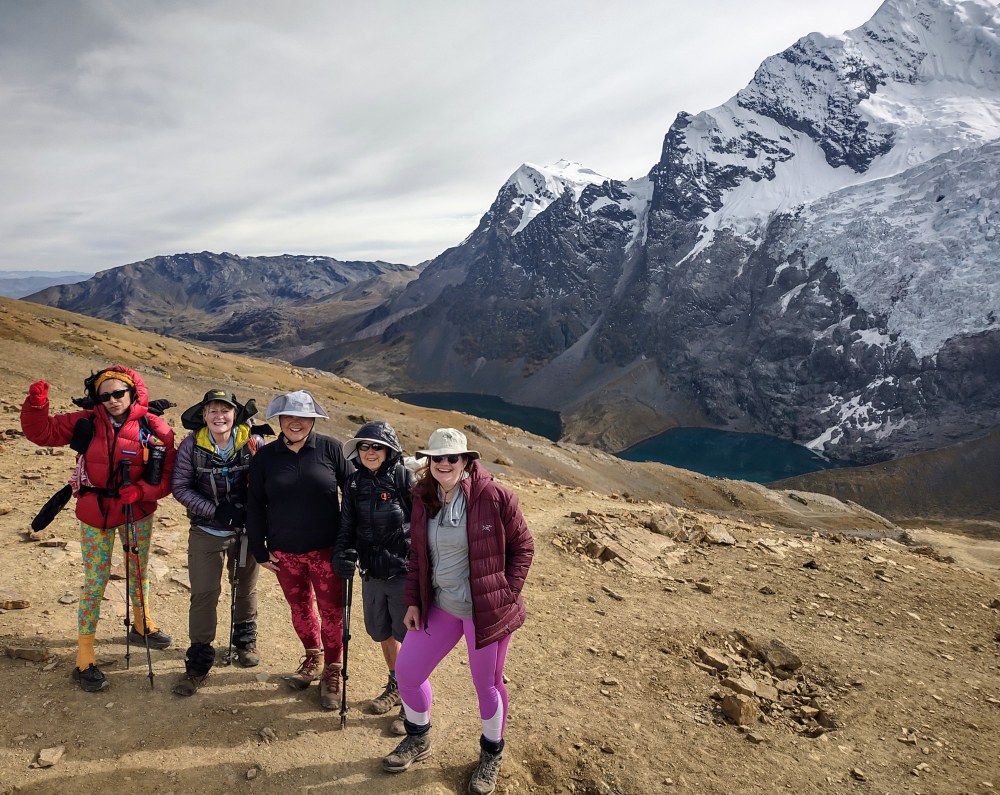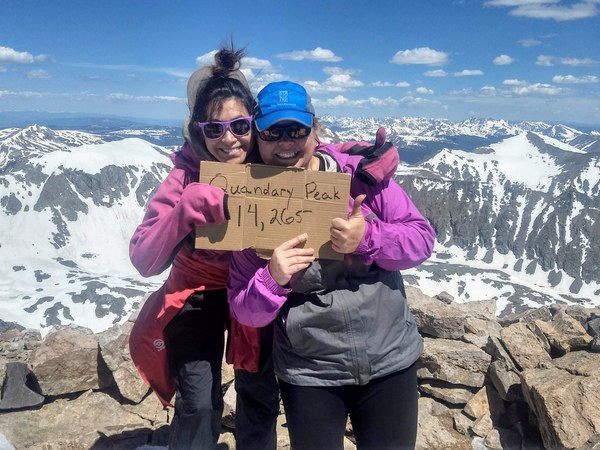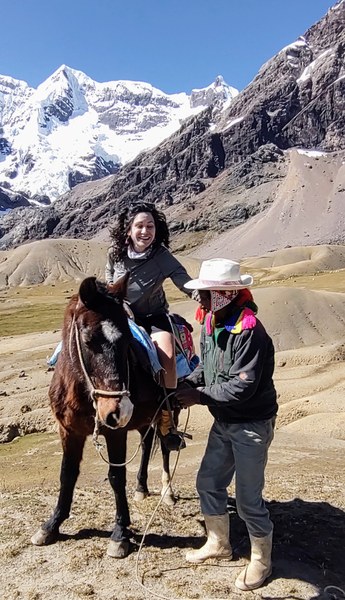
As the pandemic ebbed in 2022, five of us Mountaineers decided it was time to finally travel again. Our goal: the Ausangate Loop in Peru, a 60-mile, weeklong trek that ambles between 13,600 and 17,200 feet. We ranged in age from 43 to 68 and all identified as female-bodied. So, basically, we were five middle-aged ladies on a high-altitude adventure.
Spoiler alert: Most of us rode the "emergency horse," a lovely equine named Wayra (which means "wind" in Quechua), once or twice. She and her flute-playing horseman Ignacio accompanied us in case we got sick or winded at altitude. But we all made it—and had a blast!
Maybe you dream of climbing Mount Rainier or Mount Whitney. Or you have lofty, faraway goals like Aconcagua or Kilimanjaro. Many Mountaineers aim for new heights—literally and figuratively—but our home elevation does little to help us avoid Acute Mountain Sickness (AMS), also called altitude sickness, which can be fatal. Pro athletes and people with money can spend a few weeks—or months—in Colorado’s Breckenridge (9,600 feet) before hopping on a plane for higher pursuits. But if that’s not you, don’t despair! Paths to high altitude success abound. Our ladies tested most of them since our work schedules, vacation packages, family obligations, and finances varied. Here's our collective wisdom to help you on your next high-altitude adventure.
Make a training plan
To avoid AMS and have the best possible time, you’ll first want to make a training plan. Generally, you’ll want to ramp up your activity to match your trip objective. In January, we scheduled our trek for late May. We immediately started hoofing up Mailbox Peak, Teneriffe, Mount Ellinor, and Cleman Mountain most weekends. As the weather improved, we progressed to higher-elevation hikes, including Mount St. Helens and Camp Muir.
During the workweek, the gym was our friend.
 (Left to right) Meryl Lassen and Lisa Katzman have been "getting high" together for years. Here they are pictured at the 14,265-foot summit of Quandary Peak, Colorado, in July 2019.
(Left to right) Meryl Lassen and Lisa Katzman have been "getting high" together for years. Here they are pictured at the 14,265-foot summit of Quandary Peak, Colorado, in July 2019.
We found inspiration in a training program designed by Kitsap youth leader Debbee Maraglio-Lynn. While preparing for a self-guided Denali attempt with a Kitsap Mountaineers group in 2019, Debbee did six consecutive hikes up Mount Walker (12,000 feet) in one day.
We each put together our own training plan starting 12 weeks out:
- Suzy Diesen (Kitsap) began with sporadic 4-mile runs and stationary bike rides, but soon incorporated daily 3-mile runs and spring farm work.
- Lisa Katzman (Olympia) used a treadmill for runs, intervals, and steep walks with pack weight. She added strength, stretching, and yoga.
- Mandy Russell (Tacoma) used a stair-stepper with packweight twice a week and did heavy construction all spring, interspersed with hill walks and squat reps.
- Michelle Tirhi (Tacoma) used a Stairmaster at high speeds with pack weight three times a week, did circuit training twice a week, and hiked as part of her job.
- I used a treadmill with pack weight or took aerobics classes and did strength training on alternate days, five days a week.
For Debbee, her training built physical and mental endurance for the long days, heavy hauls, bad weather, and rotations on Denali. In addition to hiking, running, and weightlifting, she and her partner Steve Anderson built a dry-land sled that they loaded up and dragged out on evening walks, while dogs barked and neighbors cheered.
Train in an altitude chamber
Altitude chambers re-create high-altitude conditions indoors. Many high-altitude athletes use them for training, as spending even limited time “at elevation” can have long-term benefits for future high-altitude pursuits.
As a transplant from Oregon, I wholeheartedly recommend the Hypoxico gym at Evolution Healthcare in Portland if you can get there. As one of the only public altitude chambers on the West Coast, Evolution offers 30-degree treadmills, stairmasters, stationary bikes, rowing machines, air bikes, a ski erg, and a climbing treadwall, all in a high-altitude environment. An air compressor in an adjoining room puts high pressure air in a storage tank, which runs through a series of filters into the altitude room. The filters remove oxygen and increase the levels of nitrogen and other molecules until they simulate the amount of oxygen you would breathe at a high altitude. This type of training can improve oxygen delivery, fat metabolism, VO2 max, capillary density, and mitochondrial count. While technical in name, all of these things allow you to better cope with lower levels of oxygen at higher elevations.
I trained at Evolution for Kilimanjaro, Ecuadorean volcanoes, Mexican volcanoes, and two Everest Base Camp treks. My blood oxygen level regularly dropped below 70%. Normal base rate at sea level is 95-99%, and Brad Farra, the owner of Evolution, urges clients to keep it above 75%. Under 70%, I’d get loopy and leave the altitude room for ten minutes. My Kili crew called it “the best high in Portland,” which is saying a lot if you know Portland.
With enough notice, Evolution rents the altitude room overnight—a “No-Air BnB” (BYO sleeping gear, earplugs, movies, and popcorn). Brad cites research on the benefits of getting good sleep and recovering at lower elevations before "training high." I’ve personally had good results spending even more time “at altitude” by working out in the evening, sleeping all night, eating breakfast, and working out again at 14,000 feet in the Evolution room. Sometimes I leave the place feeling like roadkill, but it prepares me physically and mentally for most trekking itineraries.
 A typical home altitude sleeping system. Photo courtesy of Mile High Training.
A typical home altitude sleeping system. Photo courtesy of Mile High Training.
Rent a home altitude chamber
Noodling around Instagram in 2021, I followed Seattle coach,author, and Seven Summiter Lisa Thompson (@lisaclimbs) and saw that she used a home altitude tent. She agreed to a chat, and based on our conversation, I rented a similar setup from Mile High Training.
Home altitude systems work like the Evolution Altitude Room on a smaller scale. They are light and portable, but they simulate higher altitudes in the comfort of bedrooms and living rooms. A generator filters and pumps low-oxygen air through a hose into a mask or tent. Users can control settings to simulate 5,000 to 21,000 feet. Mile High Training Director Matt Formato recommends lowlanders use the home system for six weeks before a trip, starting at 5,000 feet and increasing elevation by approximately 1,000 feet every few days. The company provides individual protocols for shorter pre-trip timelines.
Matt recommends using at least one, ideally three training methods to maximize pre-acclimatization: 1. sleeping at altitude, 2. exercising at altitude, and 3. intermittent hypoxic breathing (IHB), or breathing with the mask on and generator at high altitude for five minutes, taking the mask off for five minutes, and repeating for up to an hour a day. By sleeping in or being exposed to a low-oxygen environment, the body makes adaptations, including increased red blood cell count to help transport oxygen. Repeated exposure to altitude leads to better on-mountain performance and lower rates of AMS.
The Mile High tent fit over my bed, and I used the mask on my treadmill at home. By the time we left, I was “living” at 15,000 feet. It made my work video calls look a bit interesting, but it worked. I did not feel sick or even slow down much in Peru.
Bring medications and supplements
Seattle guide Garrett Madison led my first high-altitude climb up Kilimanjaro in 2015. He recommended we use the altitude medication Diamox, and we all summited. According to Garrett, Diamox can be beneficial in some in some situations. The medication can help people sleep better and suffer less at elevation. But his best advice, like that of most high-altitude pros, is to “go slow.”
Diamox is a diuretic, so users should drink plenty of water, limit alcohol, and resign themselves to frequent urination. On a pre-Peru hike to Mauna Loa, my aging bladder rejected Diamox, so I switched to Ibuprofen for our trek. However, it’s worth noting that Ibuprofen can exacerbate digestive issues and aggravate the liver, kidneys, and stomach lining.
 Meryl Lassen enjoys a ride at 16,000 feet on the group's emergency horse, Wayra, led by horseman Ignacio.
Meryl Lassen enjoys a ride at 16,000 feet on the group's emergency horse, Wayra, led by horseman Ignacio.
Some guides will ask if you're taking Diamox, since it's often their first recourse for AMS symptoms (headaches, nausea, bad indigestion, dizziness, acting tipsy or confused, trouble breathing, or swelling of the face or feet). If you're already using Diamox and begin to have symptoms, you likely need to descend to a lower altitude.
Go early and have fun
It takes hard work to prepare for high altitudes, but Peru, Kilimanjaro, and Denali aren't just notches in our hip belts. They are trips of a lifetime. Most of our Peru crew spent a week in Cusco before the trek. We climbed a few "via ferrate," hiked Inca ruins, ran stairs, hung out, and just had fun. Our time at 11,200 feet helped us adjust to the elevation and to each other.
So, please don’t forget to have fun. Take pictures. Make memories. Learn from locals. Deepen friendships. Let your eyes pop and your jaws drop. Be awestruck at the wonder of these higher places.
Meryl Lassen considers themself an altitude amateur and thanks the pros and friends who shared their expertise for this article.
This article originally appeared in our spring 2023 issue of Mountaineer magazine. To view the original article in magazine form and read more stories from our publication, visit our magazine archive.
 Meryl Lassen
Meryl Lassen